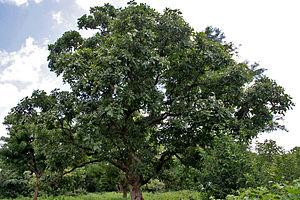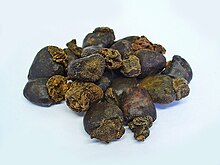Marrow fruit tree
| Marrow fruit tree | ||||||||||||
|---|---|---|---|---|---|---|---|---|---|---|---|---|

Marrow fruit tree ( Semecarpus anacardium ) |
||||||||||||
| Systematics | ||||||||||||
|
||||||||||||
| Scientific name | ||||||||||||
| Semecarpus anacardium | ||||||||||||
| Lf |
The Mark fruit tree ( Semecarpus anacardium , Syn. : Anacardium orientale auct ex Steud..), And East Indian Ink Tree , East Indian Elefantenlausbaum , East Indian shopping fruit tree or Malacca Walnut (English: Marking Nut Tree or kidney bean of Malacca , in India Bibwa, Bibba, Bhilawa) called , is a species of the sumac family (Anacardiaceae). It is native to Southeast Asia .
description
Appearance and foliage leaf
The marrow fruit tree is a medium-sized to large, deciduous tree that reaches heights of growth of 15 to 25 meters. The brown-gray, coarser bark flakes off in small, irregular pieces. The tree carries a gum or resin .
The simple leaves are arranged alternately on the branches and have short stems. The petiole is about 2.5–5 inches long. The leathery, entire leaf blades are obovate with a length of 20 to 60 centimeters with a rounded upper end. The dark green upper side of the leaf is bare and the underside of the leaf is more or less hairy and pale green. There are 15 to 25 pairs of major nerves.
Inflorescence and flower
In more or less fluffy hairy, panicle inflorescences , the short-stalked flowers stand together in bundles. The five-fold flowers with a double flower envelope are greenish-white or greenish-yellow. They are either male or hermaphrodite. There are five free stamens . The hermaphrodite flowers are three carpels to a top permanent to semi-permanent under, single-chamber and hairy ovary with three short pistils grown together. The male flowers have a hairy pestle. There is one discus each.
Fruit and seeds
The black-brown, flattened egg-shaped, leathery and single-seeded, smooth stone fruits are about 25 millimeters long and have a width of up to 20-25 millimeters. They sit on a fleshy, fully grown, orange-yellow and cup-shaped fruit stalk (hypocarp; as with the cashew ), which is edible and forms a false fruit . In the mesocarp of the later hard, poisonous fruit peel there is a blackening , bitter, caustic oil (English: Bhilawan oil ) that dries up resinous in the fresh air.
The stone fruit is also called Merknuss . The drug is called "Fructus Anacardii orientalis" are (without fruit stalk), others used name for the fruit: Anacardium , Elefantenlaus , Malacca nut , Malacca beans , cashew nut , East India Elefantenlaus, East India Heart fruit Anakardien Heart nut, nut of the ink tree.
Occurrence
The marrow fruit tree is native to the east of India . It grows in dry, forested mountain regions. This East Indian ink tree is occasionally cultivated in South Asia and other tropical countries (e.g. Australia ).
Linguistic
Anacardium orientale is composed as follows: Anacardium is derived from the Greek ana ("upwards" or "without") and kardia (heart). "Upwards" or "without" indicates that the pith nut has grown out of the fruit shell; orientale refers to the eastern, Asian homeland of this tree. The name Semecarpus is made up of the words séma (to identify ) and karpós (fruit).
use
Important ingredients and effects
Important ingredients of Mark fruit tree are anacardic , Anacardöl , phenolic acids and tannins . Anacardic acid and anacardic oil can be distributed throughout the tree or concentrated in certain areas. Contact with the corrosive oil of the fruit peel can cause itching and a rash with large blistering of the skin (roughly equivalent to grade II burns ) within 24 hours . The dermatitis can spread over the whole body. In oral absorption of this substance can violent gastrointestinal inflammation , respiratory disturbances and motor paralysis occur. In Homeopathy is Anacardium orientale (short form: Anac ) used. The remedy is made from the ripe, dried fruits (e.g. from DHU ) from the oil from the mesocarp. It is administered to people with mental and emotional disorders (conflicts of will, lack of self-esteem , emotional hardship, cruelty ) as well as with certain physical complaints ( gastritis , duodenal ulcer , hemorrhoids ).
The kernels are edible, as are the fleshy fruit stalks.
An oil can also be obtained from the seed kernels (anacardia oil).
Cultural history
The Arabs used the oily black juice of the pulp to treat mental illnesses , memory loss , paralysis and cramps . The Hindus use the sharply caustic Malacca balm for various types of skin complaints, such as for etching out warts , as a blistering agent for corns , for pickling away birthmarks or for cleaning leg ulcers and the like. The Arabs called the fruit " balador ".
Other forms of use
The "ink" (Bhilawan oil + chalk) is used to make stamp inks. In addition, this indelible ink is sometimes used in Indian laundries to mark laundry items. Contact with such a marked item of clothing can cause a skin rash in sensitive people, despite having been washed several times. This is also where the popular name "ink tree" can be traced back to. The "Bhilawan oil" is also used in India to repel termites .
Likelihood of confusion
The name Anacardium orientale should not be confused with the species name Anacardium occidentale . Anacardium occidentale , the cashew , one of is America originating fruit tree which bears the world ate cashews, which but also for the family of Sumac counts (Anacardiaceae), as did the mango tree .
swell
- G. Frerichs, G. Arends, H. Zörnig: Hagers Handbook of Pharmaceutical Practice. First volume, Springer, 1925, 1930, ISBN 978-3-662-01811-8 (reprint), p. 437 f.
- Karl Hiller, Matthias F. Melzig: Lexicon of medicinal plants and drugs. 2 volumes, approved special edition for Area Verlag, 2006, ISBN 3-89996-682-1 .
- Frans Vermeulen: Prism - Similarities and parallels between substance and drug. Emryss, 2006, ISBN 90-76189-17-X .
- Andrew Lockie: The Great Lexicon of Homeopathy. Dorling Kindersley Verlag, 2000, ISBN 3-8310-0005-0 .
- Willibald Gawlik: drug picture and personality portrait. Hippocrates, 2002, ISBN 3-8304-5213-6 .
- Andrew Lockie, Nicola Geddes: Homeopathy. BLV Verlagsgesellschaft, 1996, ISBN 3-405-14719-0 .
- SR Phatak: Homeopathic Medicine. Elsevier, 2005, ISBN 3-437-56860-4 .
- Contact Poisonous Plants of the World - Semecarpus anacardium L.
- Semecarpus anacardium Lf, Anacardiaceae at Institute of Pacific Islands Forestry - Pacific Island Ecosystems at Risk = PIER - Plant threats to Pacific ecosystems (section description).
Web links
- Semecarpus anacardium at Useful Tropical Plants.
- Semecarpus anacardium in the Lexicon of Medicinal Plants and Drugs, at Spektrum.de.



